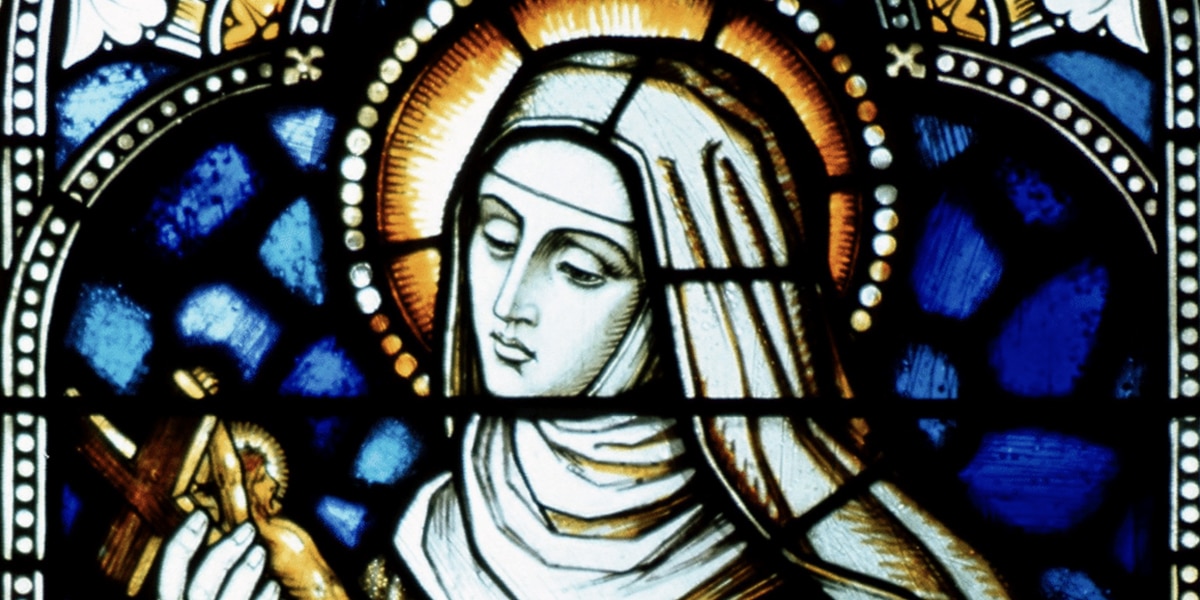She shows what the Lord accomplishes when he finds humble hearts open to his love.
Rita of Cascia (1381-1457) is one of only a very small number of saints who experienced all states of life as daughter, wife, mother, widow, and consecrated religious. Her patronage is among the most exhaustive of any saint, ranging from bodily ills to baseball. Yes, baseball!
In May 2000, on the occasion of the centenary celebration of her canonization, St. John Paul II had the incorrupt body of St. Rita in its glass coffin transported from her shrine in Cascia, Italy, to the Vatican, where he and thousands honored the saint in an outdoor prayer service.
“Why is Rita a saint?” the pontiff asked during the service. “Not just because of the wonders of her intercession. . . but for the incredible ‘normality’ of her daily existence. St. Rita is an example of what the Lord accomplishes when he finds humble hearts open to his love.”
Born Margherita Lotti in 1381 in the town of Roccaporena—just outside the city of Cascia, in the Umbrian region of Italy—Rita was known by the diminutive of her name since infancy. Her parents, Antonio and Amata (Ferri) Lotti, were revered in the area as Conciliatori di Cristo (Peacemakers of Christ), called upon frequently to act as mediators by government officials, business leaders, and common citizens alike.
Though far from aged, Amata became pregnant close to the probable end of childbearing years for that time period, and after the couple had reportedly hoped for a child for 12 years. Their faith that God would surely answer their prayers comforts would-be parents today and establishes St. Rita as a patron of infertility, sterility, pregnancy, and gynecological disorders.
Though not wealthy, the Lottis provided their daughter with a basic education in reading and writing. Young Rita was a frequent visitor to the nearby Augustinian convent of Santa Maria Magdalena, where she helped the nuns care for the sick and those who were injured in battles and local brawls. It was through Rita’s work with these wounded that she acquired her patronage of amputees and those dealing with wounds and disorders of the blood and circulatory system, such as clots and phlebitis.
A Crooked Path to Religious Life
Nearly all biographies of Rita suggest that she wanted to enter religious life early on, but was dissuaded by her parents who either implored or forced her to marry. What is recorded as fact is a marriage agreement from 1395 between Rita Lotti and Paolo Mancini, the son of Ferdinando and Teresa Mancini, of a minor noble Cascia family. Though Rita was 14 years old and Paolo 16, and in keeping with the marriage laws of the time—the couple would not live together for another two years—they were considered irrevocably joined. Two years later, at ages 16 and 18 respectively, Rita and Paolo were formally married in the local Church of San Martano.
The Mancini family had long nursed a feud with one or more of Cascia’s rival noble clans, but it was through Rita’s patient and ceaseless prayer and example that Paolo found the strength to turn his back on the violence that had characterized his upbringing. He went to work as a watchman for the city gate while Rita kept their home, and the couple soon became parents of twin boys.
Sadly, violence overshadowed their lives when, 16 years after their marriage, Paolo was murdered, probably as part of the Mancini feud with other Cascia families. And so at 32, Rita suddenly found herself a widow. Whereas she openly and often pronounced forgiveness for Paolo’s killers, the same cannot be said of her sons. They sought to avenge their father’s death by tracking down his killers in accordance with the law of vendetta—a custom so strong that even the Church at this time permitted such honor killings. Understandably, Rita’s two sons were strongly encouraged, indeed expected, to seek revenge for their father’s murder.
Rita could not bear the thought of her sons harming anyone. To prevent that she turned the situation over to the Lord, asking God to prevent her sons from becoming embroiled in the prevailing violent culture. Unfortunately, her prayer was answered, but at a heartbreaking price and certainly not as she might have imagined. Less than a year after their father’s death, both of Rita’s young sons died from illness.
Patron of Many
Such challenges in her family life have enshrined Rita as the “woman’s saint,” called upon by grieving mothers, women experiencing problems with family members and in raising children, and widows. St. John Paul II observed of the saint, “Rita well interpreted the ‘feminine genius’ by living it intensely in both physical and spiritual motherhood.”
Alone in the world, Rita renewed her relationship with the sisters at the Convent of Santa Maria Magdalena, working, praying, and staying with them as often as she could. A short time later, Rita asked to join the Augustinian convent, but was rebuffed. The refusal stemmed from the fear of both the sisters and their bishop that the still-raging feud between Rita’s Mancini relatives and the other families of Cascia would spill over into the convent, endangering the lives of the nuns and those in their care.
Sorely disappointed by her rejection—repeated several times over the course of three years and always for the same reason—Rita decided at last that the only way she would ever become a sister would be by bringing an end to the feud that had blocked her entry.
Rita undertook the seemingly impossible test of achieving peace among Cascia’s warring families. It took her a year to accomplish her mission—challenging the adversaries, reasoning with them, and, most of all, praying—but Rita was able to bring the families together in a peace compact for which she served as the primary witness.
The written agreement, recorded and notarized in 1417 and submitted to the Augustinian sisters, opened the doors to the convent to her and won the nuns’ hearts. A fresco depicting the scene of the signing of the agreement, with Rita clearly placed in a prominent position, hangs on a wall of the Church of St. Francis in Cascia.
Sharing in Christ’s Suffering Because of her success in bringing about reconciliation in Cascia, Rita is known as both The Peacemaker and as the saint of impossible and lost causes. John Paul II called Rita “the younger sister of St. Francis,” for both were native to Umbria and known for their prayerful, peacemaking abilities. Like Francis, she remains a powerful example of the merciful and forgiving spirit.
Rita spent 40 years as an Augustinian nun in the Convent of Santa Maria Magdalena. There she devoted herself to the passion of Christ, praying to share Christ’s suffering on the cross. Her prayers were answered when on Good Friday 1442, while kneeling before an image of the Jesus of Holy Saturday (also known as the Resurgent Jesus), she was gifted with a wound from a thorn from Jesus’ own crown of thorns. The thorn settled and festered in the center of her forehead for the remainder of her life.
When 20th-century doctors examined Rita’s incorrupt body, they clearly noted the wound to her forehead. They also discovered a serious degeneration of the spine, right leg, and right foot that the doctors believed indicated suffering from sciatica and arthritis, endured for much of her adult life. This revelation is the origin of her patronage of those suffering from similar afflictions involving the spine, joints, and limbs.
For the last two years of her life, Rita was confined to her bed, cared for lovingly by her fellow sisters and subsisting solely on water and the Eucharist.
Tradition holds that upon her death at age 76, on May 22, 1457, the bells of Cascia’s churches began to toll mysteriously on their own. So many people wanted to have one last look at “The Peacemaker of Cascia” that Rita’s funeral had to be delayed repeatedly and, in fact, never actually took place. Instead, the future saint was placed in an ornamental wooden coffin in front of which visitors daily knelt in prayer. Ironically, this richly decorated sarcophagus gave rise to Rita’s most famous patronage, for victims of domestic abuse.
Every account of Rita’s life paints an unfounded portrait of a wife physically abused by her husband. That error stems from the misconception that Paolo Mancini beat his wife. The Rev. Michael Gregorio, OSA, former pastor of St. Rita’s Shrine Church in Philadelphia, Pennsylvania, explains that, at the time of Rita’s death, a poem was inscribed on her ornamental coffin that spoke of her heroic love and life. As the decades passed, the inscription became so difficult to read that one line was mistranslated as Rita having to “bravely endure her ferocious husband.”
During restoration decades later, however, it was discovered that the sentence referred, not to Rita’s having to “endure her ferocious husband” but rather her “ferocious wound,” namely the partial stigmata she carried the last 15 years of her life.
Still, that Rita probably did not suffer spousal abuse does nothing to diminish her role as an intercessor for domestic strife. After all, she has always been regarded as a peacemaker for all situations, especially those involving family and loved ones.
A Compelling Story
Pope Leo XIII canonized Rita of Cascia in 1900. No doubt the fact that St. Rita’s body has remained intact and incorrupt since her death played a part in his decision. It lies today in a glass coffin at the chapel inside her shrine in Cascia.
Thousands of pilgrims pray before her body each year, and special events take place annually on her feast day. In the United States, devotees of Rita may visit her shrine in Philadelphia, Pennsylvania, administered by the Augustinians.
What makes the story of St. Rita so compelling more than 550 years after her death? In this peacemaking woman of God, we see ourselves or someone we love.
That transcendent quality is what prompted John Paul II to say of St. Rita: “Here is a woman who lived in humility and is now known throughout the world for her heroic Christian life as a daughter, wife, mother, widow, and nun. Deeply rooted in the love of Christ, Rita found in her faith unshakable strength to be a woman of peace in every situation. In her example of total abandonment to God, in her transparent simplicity and in her unflinching fidelity to the Gospel, we, too, can find sound direction for being authentic Christian witnesses.”

Sidebar: St. Rita’s Roses
During the January before Rita’s death, a cousin of hers came to visit. Before leaving the convent, the cousin asked Rita if she wanted anything. Rita asked for a rose from the garden of her former home.
Because it was winter—and with snow covering the ground—the cousin questioned the feasibility of the aging nun’s wish. When she arrived at Rita’s former home, however, among the snow-covered bushes, the cousin found a beautiful single rose in full bloom, which she joyfully carried back to the convent.
Another story tells that Rita then asked for two figs from her home, which were also found nestled in the snow. For Rita, the rose and the figs symbolized the love of her husband and their two sons. Those devoted to the saint can still visit both Rita’s former home and its legendary rosebushes.
Said St. John Paul II of Rita’s roses: “The worldwide devotion to St. Rita is symbolized by the rose. It is to be hoped that the life of everyone devoted to her will be like the rose picked in the garden of Roccaporena the winter before the saint’s death.
“That is, let it be a life sustained by passionate love for the Lord Jesus; a life capable of responding to suffering and to thorns with forgiveness and the total gift of self, in order to spread everywhere the good odor of Christ (cf. 2 Cor 2:15) through a consistently lived proclamation of the Gospel. Rita offers her rose to each of you: in receiving it spiritually strive to live as witnesses to a hope that never disappoints and as missionaries of a life that conquers death.”









8 thoughts on “St. Rita of Cascia, Peacemaker”
Pingback: Saint Rita of Cascia – Saint Gregory the Great Catholic Church
I pray to St Rita of Cascia every night. She gives me strength to carry on. I have been married almost 33 yrs. The 1st part of my marriage was a nightmare. My husband’s family were constantly verbally and emotionally abusing me. Then, the last few yrs. The family does not abuse me the way they use to. St. Rita gave me the strength to carry on, and be able to forgive sins that they have committed against me so that I will be able to ask forgiveness for the sins that I committed against God.
Thank you St. Rita of Cascia for your strength you have given me????????????!
I pray everyday to St. Rita to end wars, protect children of war, sickness and vulnerability. I also ask her to help people with terminal sickness. She has answered many prayers, God Bless Her.
Doctors told us to prepare to lose our second unborn baby. I went to mass and prayed to St Rita to intercede for us. The message I got was “to have the faith of mustard seed” and” to trust” in the prayer. Our daughter surpassed all expectations and was born health at 40 weeks.
God bless
I need the daily prayers and also the novena prayers to St. Rita, please.
St. Rita, please intercede with the good Lord on my behalf that he change the heart of my husband who was baptized, took First Communion and his Confirmation yet, in these his later years, will not attend mass saying that he is not ready, gets upset when I speak of God or of things Catholic and Spiritual. Please ask the good Lord that he change the heart of my husband to when he was younger, as God changed Saul. I believe in miracles. Thank you God, our Father. Thank you St. Rita.
My husband read to me about St Rita, and so I looked for more on her. Beautifully put. I ask for prayers for both our daughters today. Married 25 and 23 yrs. My husband and me have been married 53 years
Janie n Humberto Martinez